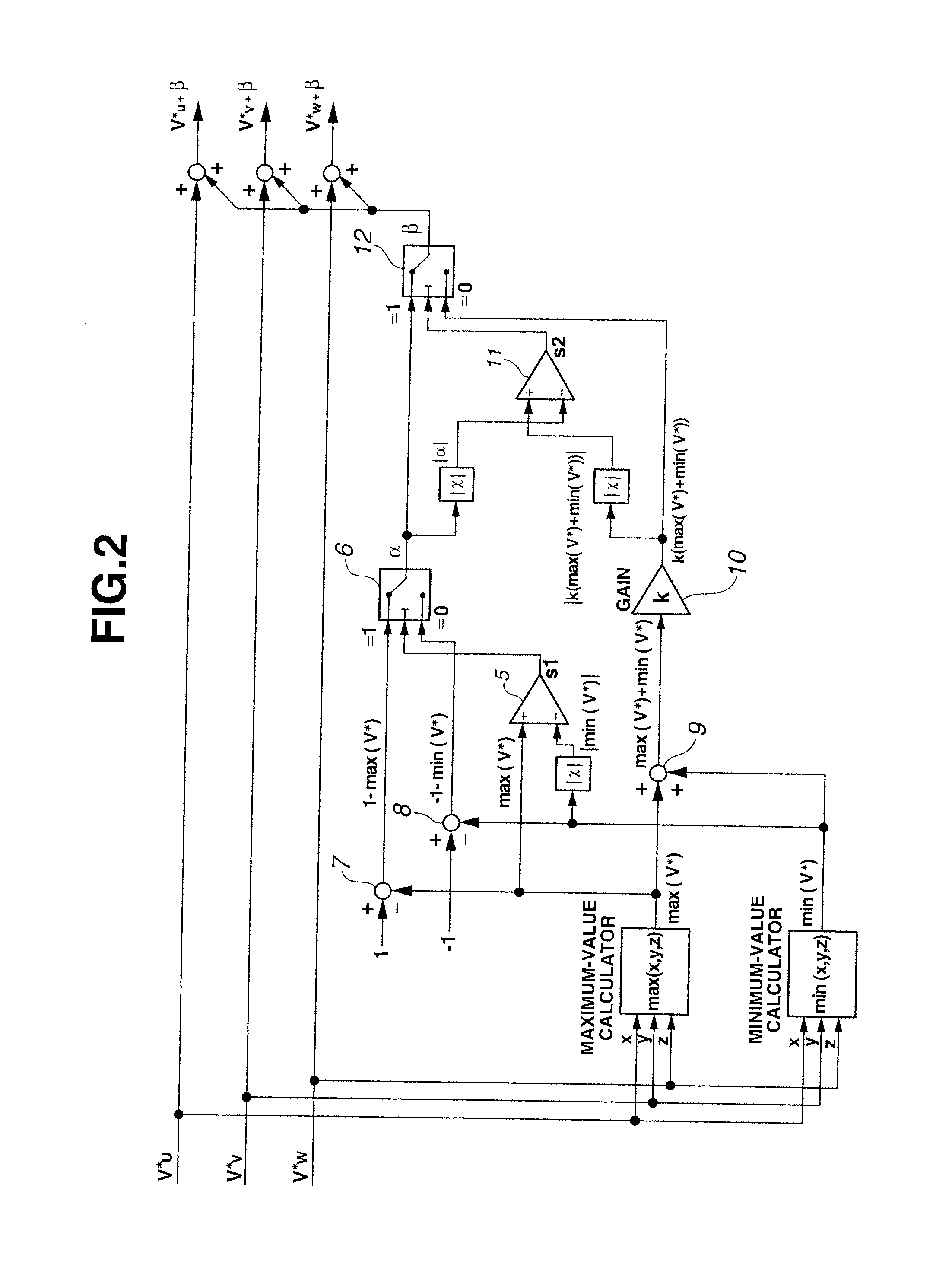Method of controlling power conversion device
a power conversion device and control method technology, applied in the direction of dc-ac conversion without reversal, power conversion systems, electrical appliances, etc., can solve the problems of large switching loss, reduced efficiency of power conversion devices, and loss of switching, so as to reduce switching loss, suppress sudden change of noise, and reduce noise
- Summary
- Abstract
- Description
- Claims
- Application Information
AI Technical Summary
Benefits of technology
Problems solved by technology
Method used
Image
Examples
first embodiment
[0046]Voltage command values V*U, V*V and V*W of three phases are inputted to a gate-signal generating section shown in FIG. 1. This gate-signal generating section outputs gate signals to semiconductor switching elements provided in a power conversion device (for example, a three-phase inverter) for performing an AC-to-DC conversion or DC-to-AC conversion. Each of the gate signals is obtained by applying a pulse-width modulation (PWM) to the voltage command value. A correction-term adder 1 adds a second correction amount (hereinafter referred to as, correction amount β to each of the voltage command values V*U, V*V and V*W of three phases, and thereby produces corrected voltage command values V*U+β, V*V+β and V*W+β, as shown in FIG. 2. Then, the correction-term adder 1 outputs the corrected voltage command values V*Uβ, V*V+β and V*W+β respectively to comparators 2. Since operations of a NOT-circuit 3 and a dead-time generating circuit 4 provided downstream of the comparator 2 in FIG...
second embodiment
[0089]In the modulation method of the first embodiment, the correction amount β is added to the three-phase voltage command values V*U, V*V and V*W. Thereby, a zero-phase voltage (i.e., a voltage to ground) is varied. However, the variation of the voltage to ground is increased, a leakage current become problematic.
[0090]Therefore, in a second embodiment according to the present invention, the gain k of the modulation method of the first embodiment is varied according to the modulation factor m.
[0091]A concrete example of the case where gain k is varied according to the modulation factor m will now be explained. FIG. 8 (a) is a time chart of the U-phase voltage command value V*U in a case that the modulation factor m is increased from 0 to 1.15 with a constant gradient. FIG. 8 (b) is a time chart of the correction amount α and the signal k(max(V*)+min(V*)). FIG. 8 (c) is a time chart of the gain k. FIG. 8 (d) is a time chart of the correction amount β. FIG. 8 (e) is a time chart of ...
third embodiment
[0095]In the second embodiment, the mixture ratio between the three-arm modulation method and the two-arm modulation method is varied in accordance with a magnitude of the modulation factor m. However, in a third embodiment according to the present invention, the mixture ratio between the three-arm modulation method and the two-arm modulation method is varied in accordance with not only the modulation factor m but also a load factor l of the power conversion device.
[0096]A main loss of the power conversion device can be classified into a conduction loss and the switching loss. FIG. 9 is an explanatory view of the switching loss. A following formula (5) represents a loss wsw per one switching. A following formula (6) represents a switching loss Wsw per unit time. For simplicity's sake, the following explanations will be given assuming that a voltage v and a current i vary linearly as shown in FIG. 9.
[Formula 5]
wsw∫Tswv·idt[J] (5)
[Formula 6]
Wsw=fsw·∫Tswv·idt[W] (6)
[0097]In such a ca...
PUM
 Login to View More
Login to View More Abstract
Description
Claims
Application Information
 Login to View More
Login to View More - R&D
- Intellectual Property
- Life Sciences
- Materials
- Tech Scout
- Unparalleled Data Quality
- Higher Quality Content
- 60% Fewer Hallucinations
Browse by: Latest US Patents, China's latest patents, Technical Efficacy Thesaurus, Application Domain, Technology Topic, Popular Technical Reports.
© 2025 PatSnap. All rights reserved.Legal|Privacy policy|Modern Slavery Act Transparency Statement|Sitemap|About US| Contact US: help@patsnap.com



